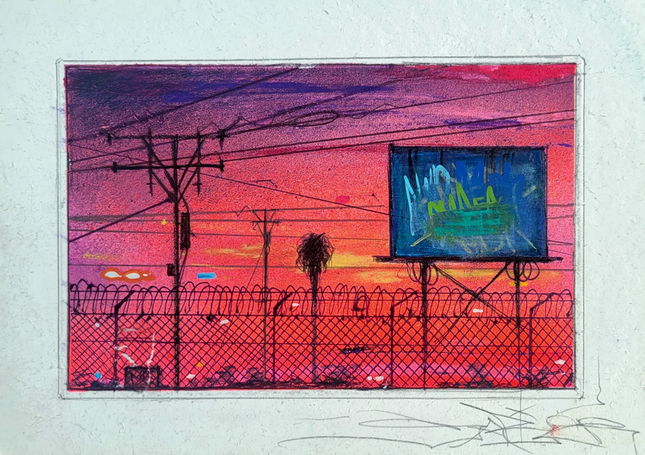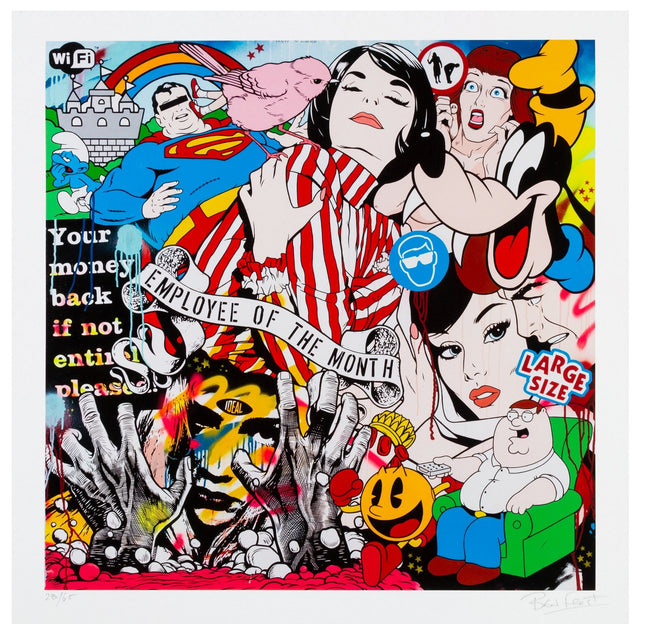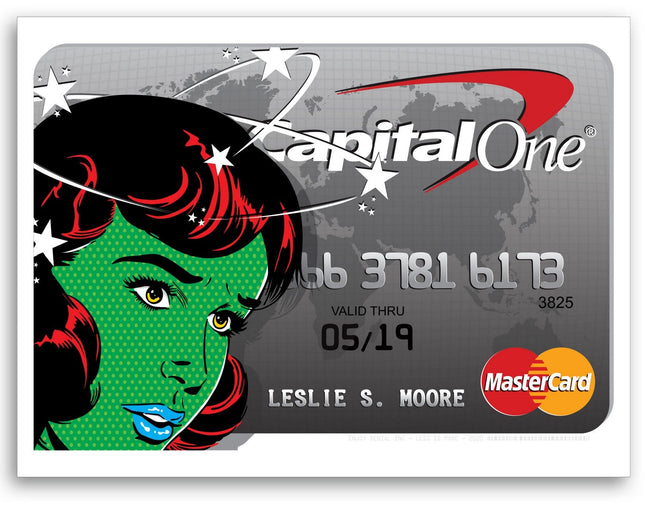
Advertising & Brands
-

Scott Listfield Fenway Archival Print by Scott Listfield
Fenway Archival Print by Scott Listfield Limited Edition Print on 290gsm Moab Entrada Rag Bright Paper Pop Artist Modern Artwork. 2023 Signed & Numbered Limited Edition of 50 Artwork Size 18x24 Archival Pigment Fine Art "Fenway Archival Print" by Scott Listfield is an art piece by the artist Scott Listfield, who is known for his distinct style of painting astronauts exploring landscapes filled with elements of pop culture and contemporary society. The title "Fenway Archival Print" is set in Fenway Park, the iconic baseball stadium in Boston, Massachusetts, home to the Boston Red Sox. Listfield has incorporated Fenway Park, the surrounding neighborhood, or some other related elements into the artwork, combined with his signature astronaut figure. Since this is an "archival print," the artwork is a high-quality reproduction of the original painting, using archival inks and paper to ensure long-lasting color and quality. These prints are often signed and numbered by the artist, making them valuable collector's items.
$533.00
-

Ron English- POPaganda Neon MC Supersized Grin Art Toy by Ron English
Neon MC Supersized Grin Limited Edition Vinyl Art Toy Collectible Artwork by street graffiti artist Ron English- POPaganda. Neon MC Supersized Grin' by Ron English- POPaganda, 2020 Collab. with toymaker Made by Monsters. 10 x 7" x 5" Inches Collectible soft vinyl art figure. Limited Edition NTWRK Exclusive colorway.
$352.00
-

Ron English- POPaganda Young MC Art Toy by Ron English- POPaganda
Young MC Limited Edition Vinyl Art Toy Collectible Artwork by street graffiti artist Ron English- POPaganda. Before there was MC Supersized, there was Young MC. Ron English- POPaganda’s iconic character has been captured in the prime of his youth in the form of a 7 inch vinyl figure with a box design by Ron English- POPaganda. The latest in Ron's ongoing POPaganda concept.
$206.00
-

Steve Kaufman SAK Punch Cigar HPM Serigraph Print by Steve Kaufman SAK
Punch Cigar Limited Edition Hand-Embellished HPM Serigraph Print on Canvas Framed by Steve Kaufman Graffiti Street Artist Modern Pop Art. Custom Frame. Arguably the most sought-after cigar piece by Steve Kaufman. Steve Kaufman (American, 1960-2010) "Punch Cigar", hand embellished serigraph, Edition 37/150 and signed in monogram en verso. Ht: 16.5" Wd: 35" By the early 90’s, Kaufman’s work was highly in demand, but he wanted to remain in touch with a broad, public audience. He staged a one-man, one-night show painting 55 “Racial Harmony” murals in New York and appeared on TV and radio to promote racial tolerance. He also created an AIDS memorial in New York City and draped red fabric over the letter “D” of the Hollywood Sign in remembrance of everyone who had died of AIDS.
$2,607.00
-

Denial- Daniel Bombardier Supreme Vuitton Smashup Pill Black Skateboard Deck by Denial- Daniel Bombardier
Supreme Vuitton Smashup Pill- Black Deck Fine Art Limited Edition Archival Pigment Print Transfer on Cold Pressed Steep Natural Skateboard Deck by Street Artwork Graffiti Artist Denial. 2022 Numbered Limited Edition of 100 Skateboard Artwork Size 8.25x31.87 Naturally, the artist has evolved as one the most prominent figures of contemporary pop artists, who nonetheless, continues to stay relevant and is interested in generating thought-provoking commentary. He has a long history of exploring the boundaries of appropriation, which he uses as a means of subverting the value of cultural products, imprinted in the collective memory of the Western civilization. His work, in other words, is inviting the viewer to re-imagine our dystopian society as a way of confronting it, with humor and irony as the biggest tools of the artist.
$466.00
-

Daniel Loveridge Supreme NYC HPM Acrylic Archival Print by Daniel Loveridge
Supreme NYC HPM Acrylic Archival Print by Daniel Loveridge Fine Art Hand-Embellished Limited Edition on 290gsm Moab Entrada Rag Bright Paper Artist Artwork. 2023 Signed & Numbered Acrylic Paint Hand Embellished Limited HPM Edition of 5 Artwork Size 17x14 "Daniel Loveridge’s gritty canvases seamlessly capture urban decay's raw and unrepentant beauty. Working predominantly in acrylic and ink on canvas, Loveridge paints en plein air, as he has for his sixteen-year-long career. Dilapidated interior scenes comprise the majority of the artist’s oeuvre. Abandoned buildings rife with decomposing tin and concrete walls are intensified by brilliantly pigmented patches of graffiti throughout his compositions." -House of Roulx
$360.00
-

Shepard Fairey- OBEY Icon Collage Bottom- Large Format Silkscreen Print by Shepard Fairey- OBEY
Icon Collage Bottom- Large Format Limited Edition Hand Pulled 3-Color Silkscreen Print on Cream Speckle Tone Paper with hand-deckled edges by Shepard Fairey Graffiti Street Artist Modern Pop Art. Screen Print 30 inches by 38 1/2 inches Edition of 70 October 31, 2016. Large Format Screen Print. 30 inches by 38 1/2 inches. Limited Numbered Edition of 70. 100% cotton archival paper with deckled edges. OBEY publishing chop on bottom left corner. Signed by Shepard Fairey.
$4,011.00
-

Denial- Daniel Bombardier Enjoy Original Stencil Spray Paint Painting by Denial- Daniel Bombardier
Enjoy Mixed Media On Cradled Wood Panel Original Painting by Denial Graffiti Street Artist Modern Pop Art. Ready To hang. "Recently this piece was not allowed into a show I had wanted it to be in. In Dubai, they have strict rules on obscenity and vulgarity. I had been wanting to paint this piece for a long time and was looking for just the right image to use as a base in it. I finally found it amongst the bowels of the internet. This painting is a visualization of an amazing Bill Hicks joke from his stand-up routine. In his stand up Bill goes into great detail about the evils of advertising when left unchallenged and unchecked. He imagines and describes an ad in the not-so-distant future that one day may exist. This painting is of that ad. Bill Hicks was a fucking genius and I only hope I did his work the justice it deserves. He was so inspirational in forming my current mindset, a true artist and rebel. I take inspiration from different artists in different ways. I like to visualize things like songs or speech or comedy and play with the different elements I come up with. I have a very playful mind." - Denial Denial has evolved as one the most prominent figures of contemporary pop artists, who nonetheless, continue to stay relevant and is interested in generating thought-provoking commentary. He has a long history of exploring the boundaries of appropriation, which he uses as a means of subverting the value of cultural products, imprinted in the collective memory of the Western civilization. His work, in other words, is inviting the viewer to re-imagine our dystopian society as a way of confronting it, with humor and irony as the biggest tools of the artist.
$8,712.00
-

Denial- Daniel Bombardier High Fashion II Hermès Blotter Print by Denial- Daniel Bombardier
High Fashion II Hermès Blotter Print by Denial- Daniel Bombardier Limited Edition Fine Art Archival Pigment Print Art on Perforated Blotter Paper. 2024 Signed & Numbered Limited Edition of 35 Archival Pigment Print on Perforated Blotter Paper Size: 7.5 x 7.5 Inches Release: April 19, 2024, Limited blotter editions are hand-perforated by Zane Kesey. High Fashion II Hermès Blotter Print by Denial High Fashion II Hermès by Denial, also known as Daniel Bombardier, captures a sharp commentary on luxury consumerism through the lens of Street Pop Art & Graffiti Artwork. Released in 2024 as a limited edition of 35 signed and numbered archival pigment prints, this 7.5 x 7.5 inch piece is printed on perforated blotter paper and hand-perforated by Zane Kesey. The work uses the instantly recognizable Hermès Paris branding and vivid orange palette to highlight the intersection of wealth symbolism and artistic subversion. As with many of Denial’s works, the use of luxury fashion iconography is both a nod to aspirational culture and a critique of its grip on identity and self-worth. Fashion as Commodity and Canvas In this print, Denial transforms the Hermès packaging into an object of reflection. The orange field, carriage motif, and Parisian serif typography remain visually intact, yet their presence on blotter paper invites reinterpretation. In the hands of Denial, this branded imagery becomes more than decorative. It takes on a satirical tone, challenging viewers to consider how brands shape desire and value. By placing this on a medium traditionally linked to psychedelia and altered consciousness, the artist brings a new layer of irony—how deep are we in the trance of consumerism when luxury logos elicit emotional responses? Street Pop Art & Graffiti Artwork as a Response to Luxury Culture Daniel Bombardier is known for blending sleek graphic sensibilities with raw social critique. His work often engages with consumerism, capitalism, and surveillance culture, and the High Fashion II Hermès print continues this thread. The piece balances reverence for the aesthetic of high-end branding with an interrogation of its psychological influence. As with the best examples of Street Pop Art & Graffiti Artwork, this print disrupts traditional spaces by repurposing symbols of status into agents of visual dissent. It belongs to a growing lineage of works that reframe logos and designer marks as objects of conversation rather than worship. The Luxury Logo as Cultural Code High Fashion II Hermès does not dilute its message. It elevates it through contrast. The clash of street aesthetics and high fashion visuals builds a dialogue about power, visibility, and access. Hermès, a brand known for restraint and craftsmanship, is reimagined in a format associated with the underground and countercultural expression. This transformation reframes luxury as something no longer untouchable, but critically examined. Denial’s work acts as a graphic mirror, held up to a society shaped by what it consumes and what it chooses to idolize. Through this limited blotter edition, Denial fuses critique and craft into a square of paper that speaks volumes.
$500.00
-

Shepard Fairey- OBEY Know Your Rights Large Format Serigraph Print by Shepard Fairey- OBEY
Know Your Rights- Large Format Limited Edition Hand Pulled 1-Color Serigraph Print on Varnished 100% Cotton Rag Archival Paper with hand-deckled edges by Shepard Fairey Graffiti Street Artist Modern Pop Art. 2014 Signed & Numbered Serigraph Artwork 42 x 42 inchesAugust 21, 201. 42 x 42 Large Format Serigraph.1 Color printed on Varnished 100% Cotton Rag Archival Paper. "Know Your Rights" is a commanding serigraph by Shepard Fairey, an artist who has cemented his place in the contemporary art scene through works that intertwine the ethos of street art with the aesthetic of modern pop art. This piece, released on August 21, 2014, is particularly noteworthy not only for its bold political message but also for the meticulous craftsmanship that goes into the production of each print. As an extensive format work, measuring an impressive 42 x 42 inches, it makes an indelible mark on the viewer, both through its scale and its strikingly stark one-color presentation on varnished 100% cotton rag archival paper, complete with hand-deckled edges. Shepard Fairey is renowned for blending fine art with the raw, in-your-face quality of street art and graffiti, and "Know Your Rights" is a prime example of this synthesis. The piece is anchored by a central image featuring an open book titled "THE FUTURE IS UNWRITTEN," encapsulating a message of empowerment and the potential for change. This is framed by laurels and a lit torch, evoking classic motifs that signify victory, knowledge, and enlightenment. The bordering texts "OBEY PROPAGANDA" and "KNOW YOUR RIGHTS" play into Fairey's recurring themes of propaganda, control, and the dissemination of information, urging the viewer to question authority and the narratives they are presented with. Each print in this limited edition is signed and numbered by Fairey, signifying its authenticity and connection to the artist's hand. The decision to use a one-color palette speaks to the work's assertive simplicity and Fairey's skill in using contrast and texture to convey depth and resonance. It's a technique that mirrors his street art roots, where messages must be given quickly and memorably. The serigraph process, a labor-intensive method of screen printing, ensures that each impression is of the highest quality, with the varnishing on the cotton rag paper adding a durable, tactile finish that also enhances the visual impact. "Know Your Rights" stands as a powerful statement in Fairey's oeuvre, reflecting his social and political advocacy rendered through his distinct pop art lens. This artwork resonates with the immediacy of street art and carries the weight of historical art traditions, bridging contemporary concerns with timeless expressions of resistance and hope.
$4,376.00
-

Futura 2000- Leonard McGurr FL-001 Marc Jacobs Pointman Monogram 40th by Futura 2000- Leonard McGurr
FL-001 Marc Jacobs Pointman Monogram 40th Anniversary Vinyl by Futura 2000- Leonard McGurr Vinyl Figure Art Toy Sculpture Collectible Artwork by Pop Street Artist. 2024 Marc Jacobs New in Box Limited Edition of 300 Pointman Monogram 40th Anniversary Artwork Size 3.75x12 New In Box Black & White Graffiti Marc Jacobs Fashion Branding 5 Points of Movement. 24A124FUVF "FUTURA (also known as FUTURA2000) is a globally-recognized artist, respected not only for his present-day creations across painting, sculpture, and drawing, but also for his pioneering role in NEW YORK's "SUBWAY SCHOOL" of graffiti in the 1980s. FUTURA and MARC recently synced up as part of a project and scholarship benefitting FREE ARTS NYC in 2022. MARC and FUTURA share a deep, mutual love for art and creative expression, and they are both dedicated to promoting the spirit and ethos of downtown NEW YORK -- the world over. This capsule collection represents MARCs design - expressed through the lens of FUTURAs universe of characters, icons, and kinetic gestures. This is the first collectible vinyl figure collaboration between artist FUTURA and fashion icon MARC JACOBS. This limited special-edition FL-001 "Pointman" was crafted to celebrate the 40th Anniversary of MARC JACOBS’ eponymous fashion house, featuring FUTURA's hand stylized monogram." -Marc Jacobs FL-001 Marc Jacobs Pointman Monogram 40th Anniversary Vinyl Figure by Futura 2000 The FL-001 Marc Jacobs Pointman Monogram 40th Anniversary Vinyl Figure by Futura 2000 is a groundbreaking collaboration between the legendary graffiti artist Leonard McGurr, known as Futura 2000, and iconic fashion designer Marc Jacobs. Released in 2024 to commemorate the 40th anniversary of Marc Jacobs' eponymous fashion house, this limited-edition vinyl figure is a true celebration of art, fashion, and street pop culture. With only 300 pieces available, the black-and-white Pointman sculpture features Futura's signature graffiti-inspired monogram and Marc Jacobs’ bold branding, making it a must-have for collectors and enthusiasts alike. A Fusion of Graffiti Art and High Fashion This special-edition Pointman embodies the seamless blend of street pop art and high fashion. Standing at 12 inches tall, with a base size of 3.75 inches, the figure is adorned in an intricate black-and-white monogram pattern that represents the kinetic energy of Futura's artistic style. The graffiti lettering, applied with meticulous detail, creates a dynamic interplay between fine art and the bold branding of Marc Jacobs. The five points of movement add a sculptural, interactive element to the piece, reinforcing its versatility as both an art object and a collectible design figure. The Vision of Futura 2000 Futura 2000, a pioneer of New York City's graffiti movement, has been celebrated globally for his innovative approach to abstract art and urban expression. Known for transcending traditional graffiti norms, Futura's work often merges bold, futuristic designs with organic, free-flowing shapes. The FL-001 Pointman Monogram figure reflects his ability to adapt his artistry to new mediums while maintaining his distinct style. By collaborating with Marc Jacobs, Futura continues to expand the reach of graffiti artwork, solidifying its place within contemporary art and design. A Monument to Marc Jacobs’ Legacy The Pointman Monogram figure also pays homage to the legacy of Marc Jacobs, who has consistently pushed the boundaries of fashion and design. This collaboration with Futura reflects Jacobs' dedication to blending creative disciplines, celebrating the energy and ethos of downtown New York. The figure not only marks the 40th anniversary of his fashion house but also reinforces his commitment to supporting art and cultural expression, as evidenced by past projects like the Free Arts NYC initiative. A Collector’s Dream Limited to just 300 pieces, the FL-001 Marc Jacobs Pointman Monogram 40th Anniversary Vinyl Figure is a highly coveted collectible. Packaged new in a custom-designed box, the figure’s exclusivity and striking design make it a centerpiece for art and fashion enthusiasts. Its timeless black-and-white palette ensures it stands out in any setting, while its cultural significance adds to its allure as an iconic collectible that bridges graffiti, pop art, and high fashion. This collaboration between Futura 2000 and Marc Jacobs represents a perfect fusion of urban culture and luxury design, making the FL-001 Pointman Monogram figure a true masterpiece of modern art.
$1,750.00
-

Saber Near Down Town LA Razor Wire Study Original Painting by Saber
Near Down Town LA Razor Wire Study Original Mixed Media Spray Paint Acrylic Painting by Saber One of a Kind Artwork on Embossed Archival Card Sheet by Street Art Pop Artist. 2023 Signed Mixed Media Acrylic Spray Paint Painting Original Artwork Size 7.5x5 "NEAR DTLA RAZOR WIRE STUDY I've been painting small studies of LA scenes at night. This is a series of hand-painted originals. Mixed media on embossed archival card sheets Size- 7.5" x 5' in signed and numbered Very limited; only a tiny batch is created with each series." -Saber. Immersing in the Urban: Saber's "Near Down Town LA Razor Wire Study" Saber's "Near Down Town LA Razor Wire Study" is a striking original mixed-media painting that offers a gritty yet beautiful snapshot of Los Angeles's urban landscape. This 2023 artwork, signed by the artist, is a unique piece meticulously created on a 7.5x5 inch embossed archival card sheet. Saber, a revered figure in the street art pop scene, captures the essence of downtown LA with a raw and expressive technique that blends spray paint and acrylics, revealing the city's character beneath its nocturnal veil. This series of hand-painted originals by Saber is more than a mere representation of the city's physical attributes; it's a deep dive into the soul of the urban environment. The mixed media on the embossed archival card accentuates the textural contrast between the harshness of razor wire and the ethereal quality of the city's skyline at night. Using spray paint, a medium synonymous with street art, imparts authenticity to the artwork, resonating with the spontaneous energy of graffiti. Saber's choice to focus on LA scenes at night tells of his intent to explore themes of isolation, boundary, and freedom. The razor wire, a symbol often associated with division and confinement, is set against the backdrop of a city known for its boundless creativity and dreams. This juxtaposition invites contemplation about the barriers—both physical and metaphorical—that define urban spaces and the lives within them. The "Near Down Town LA Razor Wire Study" is part of a minimal series emphasizing the exclusivity and collectibility of Saber's work. Each piece in the series is numbered, highlighting its position within a broader narrative that Saber constructs through these visual explorations. Collectors of street pop and graffiti artwork will find a convergence of street-level rawness and delicate art sophistication in these pieces. Saber's work stands as a compelling example of the potential of street pop art to transcend its origins and become a powerful form of contemporary fine art. The artist's ability to convey the complexity of the urban experience through the interplay of mediums, textures, and colors is a testament to his mastery of the form. His paintings are not just art objects but windows into the urban psyche, reflecting city life's vibrant and sometimes chaotic spirit. In essence, the "Near Down Town LA Razor Wire Study" series embodies the evolution of graffiti into a form of street pop art that challenges, engages, and captivates. It underscores the ongoing conversation about the value of street art within the artistic canon and its capacity to capture and comment on the essence of contemporary urban existence. Through his intimate and visceral portrayals of Los Angeles, Saber solidifies his position as a leading voice in street art pop, shaping how we perceive and interact with the surrounding cityscapes.
$563.00
-

Denial- Daniel Bombardier Burger King Archival Skateboard Deck by Denial- Daniel Bombardier
Burger King Limited Edition Archival Pigment Print Transfer on Cold Pressed Steep Natural Skate Deck art by street pop culture artist Denial. In 2000 he adopted the moniker ‘DENIAL’ as a means of poking fun at advertising, politics, and media messages that contemporary society is often ‘in denial’ about. Since then he has maintained an ongoing global street-campaign of over 500, 000 stickers, placards, and murals, using the alpha-numeric characters ‘D3N!@L’. Denial has evolved as one the most prominent figures of contemporary pop artists, who nonetheless, continue to stay relevant and is interested in generating thought-provoking commentary. He has a long history of exploring the boundaries of appropriation, which he uses as a means of subverting the value of cultural products, imprinted in the collective memory of the Western civilization. His work, in other words, is inviting the viewer to re-imagine our dystopian society as a way of confronting it, with humor and irony as the biggest tools of the artist.
$505.00
-

Sket-One Sweet Relish Condiment Canvas Giclee Print by Sket-One
Sweet Relish Condiment Canvas Pop Street Artwork Limited Edition Giclee Print on Canvas by Urban Graffiti Modern Artist Sket- One. 2022 High resolution digitally printed White semigloss artist canvas MDF stretcher frame
$103.00
-

Denial- Daniel Bombardier Rolex Designer Drugs PP Skateboard Art Deck by Denial- Daniel Bombardier
Rolex Designer Drugs PP Printers Proof Skateboard Art Deck by Denial- Daniel Bombardier Limited Edition Archival Print on Wood Skateboard Deck by Street Artwork Graffiti Artist. PP Printers Proof 2018 Marked PP Limited Edition Signed COA Skateboard Artwork Size 8x31 Skateboard Art Deck Featuring The Rolex Logo in Pill Form. Rolex Designer Drugs PP Printers Proof Skateboard Art Deck stands as a testament to the fusion of street culture, contemporary art, and iconic branding. Crafted meticulously by Denial, the pseudonym of Canadian artist Daniel Bombardier, this piece marries the subversive tone of street and graffiti art with high-end branding – a juxtaposition that has been a recurring theme in the world of pop art. Denial's ability to weave these seemingly disparate elements showcases his keen eye for culture, irony, and the potency of symbols in today's consumer-driven society. The 2018 piece, bearing the 'PP Printers Proof' mark, signifies its exclusivity as a limited edition. These proofs are preliminary versions of a printed piece, offering an insight into the artist's process and ensuring that the final prints meet the desired standards. Furthermore, it comes with a Certificate of Authenticity (COA) and is signed, offering collectors a tangible connection to Denial himself. Measuring 8x31, the skateboard deck is not just a canvas but a symbol of street culture. The deck, though an unusual choice for many traditional artists, is perfectly in sync with Denial's roots in street and graffiti art. At its center, the piece features the Rolex logo, but not as we know it. Reimagined as a pill, it comments on society's obsession with luxury and the lengths to which people might go to attain or showcase affluence. The use of the pill form, synonymous with quick fixes and temporary highs, poses questions about the fleeting nature of luxury and the societal pressures of branding. A brilliant embodiment of pop culture, luxury branding, and street art, the Rolex Designer Drugs Skateboard Art Deck by Denial is more than just a visual treat. It's a critique, a conversation, and a testament to the evolving nature of art in the 21st century.
$1,095.00
-

Denial- Daniel Bombardier Supreme Vuitton Smashup Pill Blue Skateboard Deck by Denial- Daniel Bombardier
Supreme Vuitton Smashup Pill- Blue Deck Fine Art Limited Edition Archival Pigment Print Transfer on Cold Pressed Steep Natural Skateboard Deck by Street Artwork Graffiti Artist Denial. 2022 Numbered Limited Edition of 75 Skateboard Artwork Size 8.25x31.87 Naturally, the artist has evolved as one the most prominent figures of contemporary pop artists, who nonetheless, continues to stay relevant and is interested in generating thought-provoking commentary. He has a long history of exploring the boundaries of appropriation, which he uses as a means of subverting the value of cultural products, imprinted in the collective memory of the Western civilization. His work, in other words, is inviting the viewer to re-imagine our dystopian society as a way of confronting it, with humor and irony as the biggest tools of the artist.
$505.00
-

Joshua Vides Vides Adam Skateboard Art Deck by Joshua Vides
Vides Adam Deck Limited Edition Silkscreen Skateboard deck art by street pop culture artist Joshua Vides.
$298.00
-

Mr Brainwash- Thierry Guetta Work Well Together Cyan Spray Paint Can Sculpture by Mr Brainwash- Thierry Guetta
Work Well Together- Cyan Limited Edition Spray Paint Can Sculpture Artwork by street artist graffiti & pop culture legend Mr Brainwash- Thierry Guetta. 2020 Signed & Numbered Limited Edition of 150 Artwork Size 3x8 Signed Via Thumbprint & Numbered With Custom Display Box. Ultra rare and very cool Mr Brainwash- Thierry Guetta limited edition spray paint can artwork collectibles.
$504.00
-

Ben Frost Employee of the Month Archival Print by Ben Frost
Employee of the Month Limited Edition Archival Pigment Fine Art Prints on Fine Art Paper by Graffiti Street Art and Pop Culture Artist Ben Frost. Ben Frost (b. 1975) Employee of the Month, 2014 Archival pigment print on Fine Art paper 17 x 17 inches (43.2 x 43.2 cm) (sheet) Ed. 28/65 Signed and numbered in pencil along the lower edge and published by 1xRUN, Detroit. Visual Dissection of Pop Culture "Employee of the Month" by Ben Frost is a limited edition archival pigment print that dissects and reassembles the fabric of pop culture within the context of street art and graffiti. This piece, created in 2014 and published by 1xRUN in Detroit, is a visually rich tapestry, infusing iconic imagery with subversive undertones characteristic of Frost's work. The print, measuring 17 x 17 inches, is a potent example of how street pop art and graffiti artwork can infiltrate the fine art world with its pulsating energy and color. Born in 1975, Frost has become known for his vibrant visuals that often incorporate elements from cartoons, advertising, and iconic brand imagery. "Employee of the Month" is no exception, featuring an amalgamation of figures from different realms of popular media. These images are not merely placed together but interwoven to create a narrative that speaks to the artist's and the viewer's shared cultural experiences. Subversion and Satire in Ben Frost's Art Frost's piece is a satirical nod to the recognition and rewards system prevalent in corporate culture, highlighted by the badge "Employee of the Month" amidst the chaotic backdrop of consumerist icons. The artwork delves into the themes of identity and recognition in a world saturated with branding and marketing messages. Each character and symbol is meticulously chosen to reflect the absurdity and sometimes the emptiness that can accompany the pursuit of accolades in a capitalist society. The print is signed and numbered by Frost, making each of the 65 editions a collectible piece of art. His signature not only authenticates the work but also marks it as an integral component of his artistic narrative, which often challenges the viewer to reconsider their relationship with the pervasive imagery of consumer culture. Interplay of Street Art and Archival Quality The use of archival pigment on fine art paper is a statement of the permanence Frost wishes to impart to his otherwise fleeting and ephemeral subject matter. While street art is often transient, the archival quality of these prints ensures that the vibrancy and message of the artwork endure. This duality mirrors street art and graffiti's short yet impactful nature – temporary in form but permanent in cultural impact. In summary, Ben Frost's "Employee of the Month" combines street art sensibilities and acceptable art practices, celebrating pop culture through a critical and often irreverent lens. This print stands as a testament to Frost's ability to create art that is both accessible and complex, offering a multifaceted critique of the world we navigate daily. Through his work, Frost continues to push the boundaries of street pop art and graffiti artwork, ensuring these genres' vital place within contemporary art discourse.
$1,099.00
-

Denial- Daniel Bombardier Louis Vuitton Designer Drugs PP Skateboard Art Deck by Denial- Daniel Bombardier
Louis Vuitton Designer Drugs PP Printers Proof Skateboard Art Deck by Denial- Daniel Bombardier Limited Edition Archival Print on Wood Skateboard Deck by Street Artwork Graffiti Artist. PP Printers Proof 2018 Marked PP Limited Edition Signed COA Skateboard Artwork Size 8x31 Skateboard Art Deck With Famous Louis Vuitton Logo With Stylized Pill Elements. The Louis Vuitton Designer Drugs PP Printers Proof Skateboard Art Deck stands as an iconic piece that reflects the dynamic interplay between luxury branding and the audacious spirit of street art. This masterpiece, conceptualized and brought to life by Denial, the artistic pseudonym for Canadian visionary Daniel Bombardier, offers a deep dive into the contemporary societal landscape, making it a focal point of discussion in both the pop art and street art communities. This 2018 creation is distinguished not only by its artistic flair but also by its exclusivity, being a part of a limited edition set of just 50, bearing the 'PP Printers Proof' insignia. Such proofs are preliminary versions of a final artwork, hinting at the artist's journey to the final rendition and ensuring the highest quality of the final output. Each piece from this collection is accompanied by a Certificate of Authenticity, signed by Denial, cementing its authenticity and value. With dimensions of 8x31, this skateboard deck serves as more than just a canvas—it's an emblem of the raw and unapologetic energy of street culture. The artwork predominantly features the globally recognized Louis Vuitton logo, but Denial's interpretation adds a twist. The iconic logo is intertwined with stylized pill elements, providing a critique on society's infatuation with luxury and the lengths some might go to achieve a state of transient opulence. The pill, a symbol of transient relief, perhaps suggests the ephemeral nature of materialistic luxury. An intersection of fashion, art, and social commentary, the Louis Vuitton Designer Drugs Skateboard Art Deck by Denial is not just a visual spectacle. It beckons viewers to question, reflect, and engage in a dialogue about the modern world's values and obsessions.
$1,095.00
-

Damon Johnson Crown Fried Archival Print by Damon Johnson
Crown Fried Limited Edition Archival Pigment Fine Art Prints on Cotton Fine Art Paper by Graffiti Street Art and Pop Culture Artist Damon Johnson. 7 by 22 inch archival cotton paper edition of 10 signed and numbered. Crown Fried Archival Print by Damon Johnson
$256.00
-

Takashi Murakami TM/KK Eye Love Superflat Pink Print by Louis Vuitton x Takashi Murakami TM/KK
Eye Love Superflat Pink Silkscreen Print by Louis Vuitton x Takashi Murakami TM/KK Hand-Pulled on Wove Fine Art Paper Framed Limited Edition Screenprint Artwork. 2003 Signed & Numbered Louis Vuitton x Takashi Murakami Limited Edition of 50 Artwork Size 6.9x11.75 Silkscreen Print in Custom Copper Style Frame. Eye Love Superflat Pink Silkscreen Print by Louis Vuitton x Takashi Murakami The Eye Love Superflat Pink silkscreen print, created in 2003 by Takashi Murakami in collaboration with Louis Vuitton, represents a critical moment in the convergence of high fashion and contemporary street pop aesthetics. This hand-pulled silkscreen, produced in a limited edition of 50, is printed on wove fine art paper and features Murakami’s signature fusion of luxury iconography and playful visual language. Measuring 6.9 x 11.75 inches, this artwork exemplifies the Japanese artist’s influential position within the movement of Street Pop Art & Graffiti Artwork during the early 2000s. Murakami’s Superflat Philosophy in Fashion and Art This print merges the bold branding of Louis Vuitton with Murakami’s signature Superflat style, a term he coined to describe the aesthetic and cultural flattening of traditional and digital art, consumerism, and fine art. The work presents a centrally aligned vertical composition featuring Louis Vuitton emblems—two Monogram Flowers and the iconic LV initials—framing Murakami’s jellyfish-eye motif at the center. The eye, detailed with contrasting jewel tones and dynamic, cartoon-like lashes, is one of Murakami’s recurring characters, reflecting both playfulness and cultural commentary. The stark contrast between the clean white vertical strip and the surrounding off-white border amplifies the minimalist elegance of the piece. Framed in a lavish copper-toned custom frame, the presentation further highlights the intersection between Murakami’s subversive artistry and the world of luxury branding. The juxtaposition of street culture aesthetics with the world-renowned Louis Vuitton brand underscores a larger commentary on consumerism and identity in the 21st century. Collaborative Cultural Significance The collaboration between Louis Vuitton and Murakami was a landmark event in the evolution of both street pop and luxury branding. Murakami’s reinterpretation of the LV monogram led to an iconic rebranding of the fashion house’s image, energizing it with a youthful, irreverent tone. The Eye Love Superflat series became a crucial collectible component of this moment, celebrated for its rare print editions and its position at the forefront of fashion-art collaborations. Each silkscreen is signed by Takashi Murakami and marked with edition numbering, reinforcing its status as a museum-quality fine art multiple. The use of hand-pulled silkscreen techniques gives the work a tactile and layered depth, contrasting the flatness of the Superflat theory while embracing the visual simplicity of Murakami’s cartoon-inspired visual storytelling. Legacy and Collectible Appeal This print, created during the height of Murakami’s engagement with global luxury, continues to resonate with collectors and cultural institutions alike. Its value is driven not only by its scarcity—limited to just 50 signed pieces—but by its historical significance as part of an artist-brand alliance that changed the dialogue around fashion, art, and consumerism. The framed presentation elevates it beyond print into the realm of formal art display, reinforcing the seriousness of Murakami’s playful yet incisive visual commentary. As an emblem of Street Pop Art & Graffiti Artwork, the Eye Love Superflat Pink silkscreen remains a pivotal expression of postmodern art culture.
$20,000.00
-

Mr Brainwash- Thierry Guetta Smile Cyan Spray Paint Can Sculpture by Mr Brainwash- Thierry Guetta
Smile- Cyan Limited Edition Spray Paint Can Sculpture Artwork by street artist graffiti & pop culture legend Mr Brainwash- Thierry Guetta. 2020 Signed & Numbered Limited Edition of 150 Artwork Size 3x8 Signed Via Thumbprint & Numbered With Custom Display Box. Ultra rare and very cool Mr Brainwash- Thierry Guetta limited edition spray paint can artwork collectibles.
$504.00
-

Skewville HYPE Box Silkscreen Sculpture by Skewville
HYPE Box Limited Handmade Silkscreen Wooden Box Mixed Media Sculpture Artwork by graffiti street artist modern pop artist Skewville. Very limited number hand made and signed 2021
$631.00
-

Denial- Daniel Bombardier Supreme Vuitton Smashup Pill Orange Skateboard Deck by Denial- Daniel Bombardier
Supreme Vuitton Smashup Pill- Orange Deck Fine Art Limited Edition Archival Pigment Print Transfer on Cold Pressed Steep Natural Skateboard Deck by Street Artwork Graffiti Artist Denial. 2022 Numbered Limited Edition of 25 Skateboard Artwork Size 8.25x31.87 Naturally, the artist has evolved as one the most prominent figures of contemporary pop artists, who nonetheless, continues to stay relevant and is interested in generating thought-provoking commentary. He has a long history of exploring the boundaries of appropriation, which he uses as a means of subverting the value of cultural products, imprinted in the collective memory of the Western civilization. His work, in other words, is inviting the viewer to re-imagine our dystopian society as a way of confronting it, with humor and irony as the biggest tools of the artist.
$676.00
-

Mr Brainwash- Thierry Guetta No Posts, No Bills 24x36 Paper Silkscreen Print by Mr Brainwash- Thierry Guetta
No Posts, No Bills- 24x36 Paper Limited Edition 4-Color Hand-Pulled Silkscreen Print on Archival Paper by Mr Brainwash- Thierry Guetta Graffiti Street Artist Modern Pop Art. 2021 Signed & Numbered Limited Edition of 70 Artwork Size 36x26 Mr Brainwash- Thierry Guetta 2021 NO POST, NO BILLS Paper Edition 24 X 36” print S/N of 75
$4,011.00
-

Denial- Daniel Bombardier Credit Limit Less is More Archival Print by Denial- Daniel Bombardier
Credit Limit- Less is More Limited Edition Archival Pigment Fine Art Print on 290gsm MOAB Fine Art Paper by Legend Street Art and Modern Pop Culture Artist Denial. 2020 Credit Limit- Less is More Credit Card Themed Money Art. Numbered, Signed, Stamped on Reverse, Edition of 25, 24x18, Archival Pigment Print on 290gsm MOAB Fine Art Paper. Credit Limit: Less is More by Denial Credit Limit: Less is More is an engaging archival pigment fine art print by Canadian street pop art and graffiti artist Daniel Bombardier, also known as Denial. This artwork, part of his Credit Limit series, is a bold critique of consumer culture, financial dependency, and the pervasive influence of branding in modern society. Created in 2020, the piece measures 24x18 inches and is printed on 290gsm MOAB fine art paper, ensuring the highest level of detail and vibrancy. Each piece is part of a limited edition of 25, individually signed, numbered, and stamped on the reverse, making it a prized collectible among art enthusiasts and collectors. The Visual Commentary of Less is More Less is More transforms the familiar design of a credit card into a provocative artwork that challenges societal norms and values. The central figure, a woman with green skin and a melancholic expression, is a striking pop art reimagination. Her stylized appearance, complete with halftone patterns and bold colors, evokes the graphic aesthetic of mid-century comic books. The credit card design features branding and elements that are cleverly altered to reflect Denial’s critique of consumerism and the contradictions inherent in the phrase less is more. The world map in the background hints at the global reach of financial systems and their influence on individual lives. By combining these elements, the piece offers a layered exploration of the emotional and cultural impact of materialism. Denial’s Unique Artistic Approach Daniel Bombardier’s work is celebrated for its ability to combine humor, satire, and pop culture references into thought-provoking pieces. Less is More exemplifies his skill in turning everyday objects into vehicles for social commentary. The use of a credit card as the foundation of the artwork speaks to the ubiquity of consumerism and its impact on identity and values. Denial’s meticulous attention to detail, from the crispness of the archival pigment print to the dynamic interplay of colors, ensures that the piece is both visually stunning and thematically rich. His fusion of street pop art and graffiti artwork continues to challenge audiences to rethink their relationship with consumer culture. The Cultural Significance of Credit Limit: Less is More Less is More captures the paradoxical relationship between material aspirations and the psychological toll of consumerism. It critiques the notion of equating financial success with personal fulfillment, highlighting the emotional dissonance that often accompanies the pursuit of wealth. As part of the Credit Limit series, this artwork reinforces Denial’s commentary on the systems and ideologies that shape modern life. The limited edition nature of the piece underscores its exclusivity and value as a work of art that not only resonates aesthetically but also sparks critical conversations. Denial’s ability to blend bold visuals with profound messages ensures that Less is More remains a standout piece in the world of contemporary street pop art and graffiti artwork.
$385.00
-

Shepard Fairey- OBEY Exclamation- Large Format Serigraph Print by Shepard Fairey- OBEY
Exclamation- Large Format Limited Edition Hand Pulled 2-Color Serigraph Print on Coventry Rag, 100% Cotton Custom Archival Paper with hand-deckled edges by Shepard Fairey Graffiti Street Artist Modern Pop Art. The evolution of Andre produced the simplified Obey icon face, the Obey star, and the Obey red box logo, which was inspired by the work of Barbara Kruger. These icons, along with various elements from the original sticker, became the building blocks of Shepard Fairey’s visual repertoire. Their repeated incorporation into the artwork is to mimics the strategic mechanism used by brands and advertising. Serigraph on Coventry Rag, 100% Cotton Custom Archival Paper with hand-deckled edges. 30 x 41 inches. Signed by Shepard Fairey. Numbered edition of 89.
$4,011.00
-

Mr Brainwash- Thierry Guetta Work Well Together Pink Spray Paint Can Sculpture by Mr Brainwash- Thierry Guetta
Work Well Together- Pink Limited Edition Spray Paint Can Sculpture Artwork by street artist graffiti & pop culture legend Mr Brainwash- Thierry Guetta. 2020 Signed & Numbered Limited Edition of 150 Artwork Size 3x8 Signed Via Thumbprint & Numbered With Custom Display Box. Ultra rare and very cool Mr Brainwash- Thierry Guetta limited edition spray paint can artwork collectibles.
$504.00
-

SSUR- Ruslan Karablin Molotov Silkscreen Print by SSUR- Ruslan Karablin
Molotov 4-Color Hand-Pulled Limited Edition Silkscreen Print on Fine Art Paper by SSUR- Ruslan Karablin Rare Street Art Famous Pop Artwork Artist. Silkscreened print limited to 50 pieces. Signed and numbered with embossed logo on the bottom corner.
$323.00
-

Mark Powell Pep Boys Original Pen Drawing by Mark Powell
Pep Boys Original Pop Street Art Pen Drawing on Fine Art Paper by Artist Mark Powell. 2022 12.2x24 Signed Ball Point Pen Drawing is protected by an archival UV protective matt varnish spray.
$854.00
-

Denial- Daniel Bombardier Credit Limit Chase Your Tail Archival Print by Denial- Daniel Bombardier
Credit Limit- Chase Your Tail Limited Edition Archival Pigment Fine Art Print on 290gsm MOAB Fine Art Paper by Legend Street Art and Modern Pop Culture Artist Denial. Credit Limit- Chase Your Tail Credit Card Themed Money Art. Numbered, Signed, Stamped on Reverse, Edition of 25, 24x18, Archival Pigment Print on 290gsm MOAB Fine Art Paper. Credit Limit: Chase Your Tail by Denial Credit Limit: Chase Your Tail is a striking example of Denial’s ability to fuse humor, critique, and nostalgia into a powerful statement through street pop art and graffiti artwork. This 24x18-inch archival pigment fine art print is part of a limited edition of 25, each one numbered, signed, and stamped on the reverse, printed on 290gsm MOAB fine art paper. Created by Canadian artist Daniel Bombardier, also known as Denial, this work continues his exploration of consumer culture and societal constructs, blending pop culture references with biting social commentary. The design uses the format of a credit card to critique financial systems and human behavior in a consumer-driven world. Thematic Depth and Symbolism Chase Your Tail reimagines a credit card with a fantastical twist, featuring a ferocious werewolf clutching a bag of money. This imagery encapsulates the relentless pursuit of wealth and the predatory nature of financial systems. The werewolf, a symbol of transformation and untamed instinct, serves as a metaphor for the primal and often destructive drives behind consumerism. The card's design, with its playful alteration of familiar branding, highlights the endless cycle of chasing financial stability while remaining ensnared in debt and materialism. This artwork invites viewers to reflect on the personal and societal consequences of these pursuits, all while maintaining the bold and accessible aesthetic of street pop art. Denial’s Artistic Perspective Daniel Bombardier’s work is celebrated for its wit, visual appeal, and ability to critique contemporary issues. Chase Your Tail exemplifies his talent for transforming everyday symbols into powerful artistic statements. By incorporating the universally recognizable format of a credit card, Denial draws attention to the ways in which consumer culture shapes identity and behavior. His use of vibrant colors and graphic elements reflects the influence of graffiti artwork, while the meticulous details of the archival pigment print demonstrate his commitment to quality. This combination of high craftsmanship and provocative themes is a hallmark of Denial’s approach to modern street pop art. The Cultural Impact of Chase Your Tail Chase Your Tail resonates with audiences by addressing themes of greed, power, and the cyclical nature of consumerism. It critiques the financial systems that perpetuate inequality and the cultural obsession with wealth, presenting these ideas in a format that is both accessible and impactful. The limited edition nature of the print enhances its value as a collectible, while the artwork’s message remains relevant in a world increasingly dominated by credit, debt, and economic disparity. This piece is a testament to Denial’s ability to use street pop art and graffiti artwork as a means of questioning societal norms and sparking critical conversations.
$385.00
-

Denial- Daniel Bombardier High Fashion I Louis Vuitton Blotter Print by Denial- Daniel Bombardier
High Fashion I Louis Vuitton Archival Blotter Paper Print by Denial- Daniel Bombardier Limited Edition Fine Art Archival Pigment Print Art on Perforated Blotter Paper. 2024 Signed & Numbered Limited Edition of 35 Archival Pigment Print on Perforated Blotter Paper Size: 7.5 x 7.5 Inches Release: April 19, 2024, Limited blotter editions are hand-perforated by Zane Kesey. Luxury Satirized in Street Pop Art & Graffiti Artwork High Fashion I Louis Vuitton by Denial, the alias of Canadian artist Daniel Bombardier, is a limited edition archival pigment print presented on perforated blotter paper. Released in April 2024 in an edition of 35, this work merges the aesthetics of luxury branding with a provocative medium traditionally associated with underground psychedelic culture. The iconic Louis Vuitton monogram and checkerboard pattern are front and center, layered in a meticulous design that plays with status, obsession, and commodification. Each edition is hand-perforated by Zane Kesey, creating a textural and conceptual connection between art, counterculture, and consumption. Daniel Bombardier’s Weaponized Iconography Daniel Bombardier has long explored the themes of consumerism and propaganda through his Street Pop Art & Graffiti Artwork. Under the name Denial, his pieces critique mass media, brand worship, and political manipulation. High Fashion I Louis Vuitton continues this practice by spotlighting a fashion house that represents wealth and global prestige. Bombardier’s use of a blotter sheet format, with its history in psychedelic counterculture and illicit print art, directly confronts the polished commercialism of high fashion. The tension between drug ephemera and elite design language becomes a visual statement about escapism, identity, and class divisions. Blotter Paper as Cultural Canvas The use of blotter paper is not just stylistic—it is symbolic. In the underground art world, perforated blotters serve as miniature canvases for satire and resistance. When applied to corporate logos or social icons, they become critiques of power and conformity. This edition's precision printing and clean finish contrast sharply with its renegade medium. Bombardier subverts the traditional format by maintaining luxury’s polished aesthetic while embedding it in a context known for anti-establishment expression. Each square of the print, though undosed, carries the historical weight of psychedelia and the DIY ethos of protest art. Reclaiming Commercial Imagery through Street Pop Commentary High Fashion I Louis Vuitton is a synthesis of controlled craftsmanship and critical commentary. The fusion of luxury branding with the modular form of blotter tabs invites questions about replication, status, and the ritual of purchasing identity. This is not simply appropriation; it is transformation. In the hands of Denial, Louis Vuitton’s visual empire becomes a satirical map, charting the boundaries between aspiration and illusion. Within the context of Street Pop Art & Graffiti Artwork, this piece asserts that nothing is above reinterpretation—not even fashion’s most sacred icons.
$500.00
-

Denial- Daniel Bombardier Acid Test Results Blotter Paper Archival Print by Denial- Daniel Bombardier
Acid Test Results Blotter Paper Limited Edition Archival Pigment Print Art on Perforated Blotter Paper by Denial pop culture LSD artwork. In 2000 he adopted the moniker ‘DENIAL’ as a means of poking fun at advertising, politics, and media messages that contemporary society is often ‘in denial about. Since then he has maintained an ongoing global street-campaign of over 500, 000 stickers, placards, and murals, using the alpha-numeric characters ‘D3N!@L’. Intended as a conceptual means of marketing absurdism, DENIAL also challenges traditional notions of graffiti and public art through his bold and often satirical visual subversions. Denial has evolved as one the most prominent figures of contemporary pop artists, who nonetheless, continue to stay relevant and is interested in generating thought-provoking commentary. He has a long history of exploring the boundaries of appropriation, which he uses as a means of subverting the value of cultural products, imprinted in the collective memory of the Western civilization. His work, in other words, is inviting the viewer to re-imagine our dystopian society as a way of confronting it, with humor and irony as the biggest tools of the artist.
$385.00
-

Denial- Daniel Bombardier Instagram Pill Archival Skateboard Deck by Denial- Daniel Bombardier
Instagram Pill Limited Edition Archival Pigment Print Transfer on Cold Pressed Steep Natural Skate Deck art by street pop culture artist Denial. 2019 Limited Edition of 50 In 2000 he adopted the moniker ‘DENIAL’ as a means of poking fun at advertising, politics, and media messages that contemporary society is often ‘in denial’ about. Since then he has maintained an ongoing global street-campaign of over 500, 000 stickers, placards, and murals, using the alpha-numeric characters ‘D3N!@L’. Denial’s art is strongly political and social since the artist takes specific positions against issues, such as capitalism, consumer culture, and advertisements. More importantly, the artist is aware of his choices and motivations: “I like to think of myself as activist pop art. How I relate with cartoons and graphics is a lot easier than I do with photo-realistic stuff" Another aspect of Denial's work is humor. His work is satirical, which, by definition, means that it uses humor as a confronting mechanism.
$505.00
-

Timba Smits Flux Capacitor Ad Giclee Print by Timba Smits
Flux Capacitor Ad- 1.21 Gigawatts Artwork Giclee Limited Edition Print on Fine Art Paper by Pop Culture Graffiti Artist Timba Smits.
$217.00
-

Mr Brainwash- Thierry Guetta Love is the Answer Red Spray Paint Can Sculpture by Mr Brainwash- Thierry Guetta
Love is the Answer- Red Limited Edition Spray Paint Can Sculpture Artwork by street artist graffiti & pop culture legend Mr Brainwash- Thierry Guetta. 2020 Signed & Numbered Limited Edition of 150 Artwork Size 3x8 Signed Via Thumbprint & Numbered With Custom Display Box. Ultra rare and very cool Mr Brainwash- Thierry Guetta limited edition spray paint can artwork collectibles.
$504.00
-

SSUR- Ruslan Karablin War & Peace Silkscreen Print by SSUR- Ruslan Karablin
War & Peace 3-Color Hand-Pulled Limited Edition Silkscreen Print on Fine Art Paper by SSUR- Ruslan Karablin Rare Street Art Famous Pop Artwork Artist. Silkscreened print limited to 50 pieces. Signed and numbered with embossed logo on the bottom corner.
$323.00
-

Ron English- POPaganda Smack, Crack & Pot Obesios Black Art Toy by Ron English- POPaganda
Smack, Crack & Pot- Obesios Black Limited Edition Vinyl Art Toy Collectible Artwork by street graffiti artist Ron English- POPaganda. 2021 Limited Edition Super limited special black colorway of the newest cereal killer figure "Obesios" Edition of 100. Collect all the cereal killer figures to form your own Last Fat Breakfast! Soft vinyl, appr. 8" tall..
$264.00
-

Ron English- POPaganda Uncle Scam Ad Flag Giclee Print by Ron English- POPaganda
Flush Giclee Print by Ron English- POPaganda Artwork Limited Edition Print on Fine Art Paper Graffiti Pop Street Artist. 2022 Signed & Numbered Limited Edition of 30 Artwork Size 37x25 Uncle Scam Ad Flag Giclee Print is a work of art by Ron English- POPaganda, a contemporary American artist known for his thought-provoking, often satirical and subversive street art, paintings, and sculptures. English is famous for creating art that highlights the absurdity of modern society, often blending elements of pop culture, advertising, and politics. In this particular piece, the artist critiques consumerism and the advertising industry by combining elements of the American flag with a caricature of Uncle Sam, who is transformed into "Uncle Scam." The term "Uncle Scam" refers to the idea that the advertising industry often manipulates consumers and promotes excessive materialism, which can be detrimental to society as a whole. A giclee print is a high-quality digital printing method that is capable of producing vivid and detailed reproductions of artwork. This process uses specialized inkjet printers and archival-quality inks, which are applied to various substrates, such as canvas or fine art paper, to create a long-lasting and visually appealing print. The result is a reproduction that retains the original artwork's colors and details, making it a popular choice for artists and collectors alike.
$1,558.00
-

Tim Conlon Tropic-Ana Silkscreen Print by Tim Conlon
Tropic-Ana 16-Color Hand-Pulled Limited Edition Silkscreen Print on 330gsm Orange Plike Paper by Tim Conlon Rare Street Art Famous Pop Artwork Artist. 2022 Signed & Numbered Limited Edition of 75 Artwork Size 24x24 Orange Tropicana Logo Close-Up of Rail Car, Truck or Shipping Container. Tim Conlon, celebrated for his profound impact on the street and pop art realms, brings forth "Tropic-Ana," an exquisite 16-color hand-pulled silkscreen print. The artwork, impressively produced on 330gsm Orange Plike paper, radiates with vibrant colors and intricate detailing that Conlon is renowned for. Measuring 24 x 24 inches, it's a creation that's impossible to overlook. With a limited edition release of only 75 pieces, each deckled-edge print is directly signed by the artist himself, adding an intimate touch of authenticity for collectors and enthusiasts alike. At the heart of this piece is its connection to Conlon's much-acclaimed "Blank Canvas" series. Specifically, it draws inspiration from his original painting, "Blank Canvas #115 - TPIX." This series is emblematic of Conlon's expertise in weaving together elements of spray paint, intricate typography, abstract painting techniques, and tromp l'oeil. Through "Tropic-Ana," Conlon offers viewers a close-up, almost magnified, perspective of the freight train painting culture, a niche yet deeply expressive sub-domain of street art. Conlon's innovative approach to meshing traditional painterly styles with the raw energy of graffiti art makes "Tropic-Ana" not just a print but a storytelling canvas. This collaboration with BEYOND THE STREETS further cements the artwork's significance, with the print edition bearing the organization's distinct embossing, signaling its approval and association with one of the modern art world's most influential entities. "Tropic-Ana" stands not just as a testament to Conlon's artistic prowess but also as a celebration of the street and pop art movement's evolution and dynamism. Signed Tim Conlon Tropic-Ana, 2022 16-Color Screen Print on Orange Plike 330 gsm Deckled Edge 24 x 24 in( 61 x 61 cm) Edition of 75 Direct Signature by the artist Embossed by BEYOND THE STREETS Based on his original painting Blank Canvas #115 - TPIX, from his prolific and ever-expanding Blank Canvas series, BEYOND THE STREETS is thrilled to present a rare print edition from iconic painter and graffiti writer Tim Conlon. Combining spray paint, typography, painterly abstraction, and tromp l'oeil to create these large-scale, close-up paintings, Conlon presents a literal "peek" into freight train painting art and culture.
$493.00
-

Shepard Fairey- OBEY Obey Long Playing AP Silkscreen Print by Shepard Fairey- OBEY
Obey Long Playing AP Dance Floor Riot Silkscreen Print by Shepard Fairey- OBEY Artist Proof Hand-Pulled 1-Color Screen Print on Fine Art Paper Limited Edition Graffiti Pop Street Artwork. AP Artist Proof 2011 Signed & AP Marked Limited Edition Artwork Size 13x13 "Long before I knew about art galleries or even street art, I was excited about album cover art, if only because it was the visual counterpart to the music on the records I loved. Album covers conjured a euphoric association with the listening experience. Most of my earliest home-made tee shirts were stencils based on punk album covers… No matter how much I love art, or try to convince myself of its relevance in society, the fact remains that music is a lot cooler and way more able to reach people’s hearts and minds… but I’m a populist and I look at it this way: I may not play an instrument, but I’m gonna rock it hard as nails anyway. With my art I try to capture the same energy and spirit that makes music so powerful and democratic. REVOLUTIONS is a celebration of all the great music and accompanying art that has inspired me over the years." -Shepard Fairey Obey Long Playing AP by Shepard Fairey: A Fusion of Music and Street Pop Art The Obey Long Playing Artist Proof silkscreen print by Shepard Fairey is a striking homage to the enduring influence of music on visual culture. Created in 2011, this limited-edition Artist Proof measures 13 by 13 inches and is hand-pulled as a one-color screen print on fine art paper. Signed and marked as an Artist Proof by Fairey, the print is a part of his Revolutions series, which celebrates the intersection of music and art. Through its bold, monochromatic design, this artwork captures the timeless appeal of vinyl records and the cultural legacy they represent. The design prominently features a stylized vinyl record encased in a decorative frame with ornate flourishes. The bold typography reading Obey Long Playing Records evokes the aesthetic of vintage album covers, blending nostalgia with Fairey’s contemporary Street Pop Art sensibilities. The intricate detailing in the border contrasts with the minimalist central image, creating a composition that is both visually dynamic and conceptually rich. This piece reflects Fairey’s deep connection to music as a driving force in his art, highlighting the shared energy and accessibility of music and street art. Music as a Visual and Cultural Inspiration Shepard Fairey’s connection to music runs deep, influencing much of his work, including Obey Long Playing. Growing up immersed in the punk rock scene, Fairey drew inspiration from the DIY ethos and rebellious spirit of the music. This influence is evident in his bold graphics and use of stencils, techniques rooted in the graffiti art tradition. In this piece, Fairey channels the energy and democracy of music into a visual form, celebrating its ability to unite people and transcend boundaries. The vinyl record featured in the design symbolizes a golden era of music, where physical albums and cover art played a crucial role in defining an artist’s identity. Fairey’s choice to emphasize this cultural artifact speaks to his admiration for the tangible connection between music and its audience. The print serves as a tribute to the artistry of album design and its ability to evoke powerful emotions, much like the music it represents. The Craft of Silkscreen Printing Obey Long Playing is a testament to Shepard Fairey’s mastery of the silkscreen printing process. Each print is meticulously hand-pulled, ensuring a high level of precision and quality. The one-color design allows for bold contrasts and sharp details, highlighting the intricacies of the decorative border and the clean lines of the central typography. Printed on fine art paper, the piece has a refined finish that enhances its visual impact and durability. The Artist Proof designation adds an element of rarity and exclusivity to this work, often representing the initial versions of a print used to refine the design. Fairey’s dedication to the silkscreen medium reflects his commitment to the traditions of graffiti and street art, where stenciling and hand-printing are integral to the art form. This choice of medium further emphasizes the tactile and authentic qualities that define Fairey’s work. Shepard Fairey: A Voice in Street Pop Art and Graffiti Artwork Shepard Fairey, an American artist and activist, has become synonymous with Street Pop Art and Graffiti Artwork. Known for his iconic designs that blend cultural commentary with bold aesthetics, Fairey’s work often draws on his love of music, particularly punk and hip-hop. Obey Long Playing exemplifies this connection, serving as both a celebration of music’s cultural significance and a reflection of its influence on Fairey’s art. Through his Revolutions series, Fairey explores the symbiotic relationship between music and visual art, creating works that resonate across generations. Obey Long Playing stands out as a powerful tribute to the legacy of vinyl records, blending nostalgia with modern artistic techniques. Fairey’s ability to capture the energy and spirit of music in visual form cements his place as a leading figure in contemporary Street Pop Art and Graffiti Artwork.
$285.00
-

Scott Listfield Why Not Zoidberg? Archival Print by Scott Listfield
Why Not Zoidberg? Artwork Giclee Limited Edition Print on Fine Art Paper by Pop Culture Graffiti Artist Scott Listfield.
$360.00
-

Denial- Daniel Bombardier Fashion Addict Refill Versace 2 AP Archival Print by Denial- Daniel Bombardier
Fashion Addict Refill- Versace 2 Limited Edition Archival Pigment Fine Art Print on 330gsm Canon Fine Art Paper by Legend Street Art and Modern Pop Culture Artist Denial. AP Artist Proof 2019 Signed Limited Edition of 100 Artwork Size 18x24 Versace 2 Designer Fashion Drug Pill. AP Artist Proof Numbered, Signed, Stamped on Reverse, Normal Edition of 100, 18x24, Archival Pigment Print on 330 GSM Canon Fine Art Paper. Essentially, Denial is satirizing the reality, which both he and us are experiencing, through some of the Western culture’s most emblematic symbols. Denial is utilizing cultural products with the intention to make a statement against the system, which gave birth to them. As a result, he re-contextualizes them and transforms them from commercial products to his cultural legacy.
$572.00
-

Supreme Spaghetti Skateboard White Skateboard Art Deck by Supreme
Spaghetti Skateboard- White Deck Fine Art Limited Edition Archival Pigment Print Transfer on Natural Veneer Wood Skateboard Deck by Street Artwork Graffiti Artists at Supreme. 2021 Spaghetti Skateboard- White 8.375" x 32.125" Supreme skate deck with natural veneer and black top ply. Printed graphic on the bottom with printed World Famous and box logo on top.
$206.00
-

Mr Brainwash- Thierry Guetta Smile Pink Spray Paint Can Sculpture by Mr Brainwash- Thierry Guetta
Smile- Pink Limited Edition Spray Paint Can Sculpture Artwork by street artist graffiti & pop culture legend Mr Brainwash- Thierry Guetta. 2020 Signed & Numbered Limited Edition of 150 Artwork Size 3x8 Signed Via Thumbprint & Numbered With Custom Display Box. Ultra rare and very cool Mr Brainwash- Thierry Guetta limited edition spray paint can artwork collectibles.
$504.00
-

Stinkfish El Halcon del Mar Black Archival Print by Stinkfish
El Halcon del Mar- Black Limited Edition Archival Pigment Prints with Black Screen Print on 310gsm Fine Art Paper by Stinkfish Graffiti Street Artist Modern Pop Art. "I found this magazine in a second-hand bookstore in downtown Bogota. I used a traditional ink fine marker over the magazine cover. It is a Chilean magazine from 1959.I usually draw over these kinds of surfaces, like vintage records and magazine covers. It's inspired by my street works, I work on portraits mixed with free hand styles with a spray can." - Stinkfish
$134.00
-

Mr Brainwash- Thierry Guetta Just Kidding Cyan Spray Paint Can Sculpture by Mr Brainwash- Thierry Guetta
Just Kidding- Cyan Limited Edition Spray Paint Can Sculpture Artwork by street artist graffiti & pop culture legend Mr Brainwash- Thierry Guetta. 2020 Signed & Numbered Limited Edition of 150 Artwork Size 3x8 Signed Via Thumbprint & Numbered With Custom Display Box. Ultra rare and very cool Mr BRainwash limited edition spray paint can artwork collectibles.
$504.00

















































